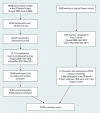Perfluorooctanoic acid (PFOA) exposures and incident cancers among adults living near a chemical plant
- PMID: 24007715
- PMCID: PMC3855514
- DOI: 10.1289/ehp.1306615
Perfluorooctanoic acid (PFOA) exposures and incident cancers among adults living near a chemical plant
Abstract
Background: Perfluorooctanoic acid (PFOA) is a synthetic chemical ubiquitous in the serum of U.S. residents. It causes liver, testicular, and pancreatic tumors in rats. Human studies are sparse.
Objective: We examined cancer incidence in Mid-Ohio Valley residents exposed to PFOA in drinking water due to chemical plant emissions.
Methods: The cohort consisted of adult community residents who resided in contaminated water districts or worked at a local chemical plant. Most participated in a 2005-2006 baseline survey in which serum PFOA was measured. We interviewed the cohort in 2008-2011 to obtain further medical history. Retrospective yearly PFOA serum concentrations were estimated for each participant from 1952 through 2011. Self-reported cancers were validated through medical records and cancer registry review. We estimated the association between cancer and cumulative PFOA serum concentration using proportional hazards models.
Results: Participants (n = 32,254) reported 2,507 validated cancers (21 different cancer types). Estimated cumulative serum PFOA concentrations were positively associated with kidney and testicular cancer [hazard ratio (HR) = 1.10; 95% CI: 0.98, 1.24 and HR = 1.34; 95% CI: 1.00, 1.79, respectively, for 1-unit increases in ln-transformed serum PFOA]. Categorical analyses also indicated positive trends with increasing exposures for both cancers: for kidney cancer HRs for increasing exposure quartiles were 1.0, 1.23, 1.48, and 1.58 (linear trend test p = 0.18) and for testicular cancer, HRs were 1.0, 1.04, 1.91, 3.17 (linear trend test p = 0.04).
Conclusions: PFOA exposure was associated with kidney and testicular cancer in this population. Because this is largely a survivor cohort, findings must be interpreted with caution, especially for highly fatal cancers such as pancreatic and lung cancer.
Conflict of interest statement
The authors declare they have no actual or potential competing financial interests.
Comment in
-
PFOA and cancer in a highly exposed community: new findings from the C8 science panel.Environ Health Perspect. 2013 Nov-Dec;121(11-12):A340. doi: 10.1289/ehp.121-A340. Environ Health Perspect. 2013. PMID: 24284021 Free PMC article. No abstract available.
References
-
- Bergmann MM, Calle EE, Mervis CA, Miracle-McMahill HL. Validity of self-reported cancers in a prospective cohort study in comparison with data from state cancer registries. Am J Epidemiol. 1998;147(6):556–562. - PubMed
-
- Biegel LB, Hurtt ME, Frame SR, O’Connor JC, Cook JC. Mechanisms of extrahepatic tumor induction by peroxisome proliferators in male CD rats. Toxicol Sci. 2001;60(1):44–55. - PubMed
-
- Butenhoff J, Costa G, Elcombe C, Farrar D, Hansen K, Iwai H, et al. Toxicity of ammonium perfluorooctanoate in male cynomolgus monkeys after oral dosing for 6 months. Toxicol Sci. 2002;69(1):244–257. - PubMed
Publication types
MeSH terms
Substances
LinkOut - more resources
Full Text Sources
Other Literature Sources
Molecular Biology Databases

